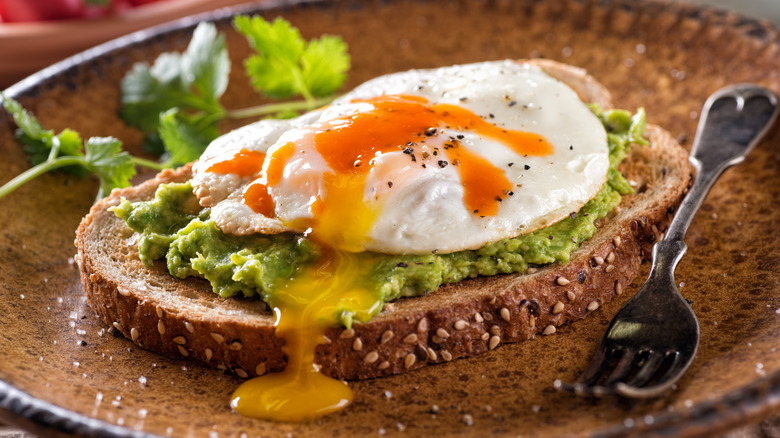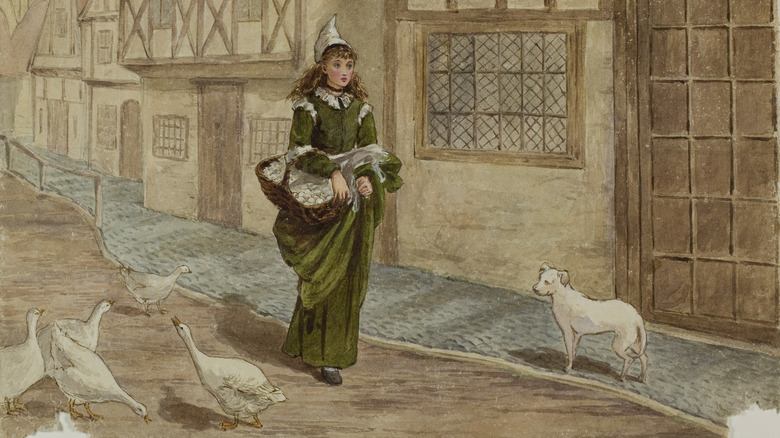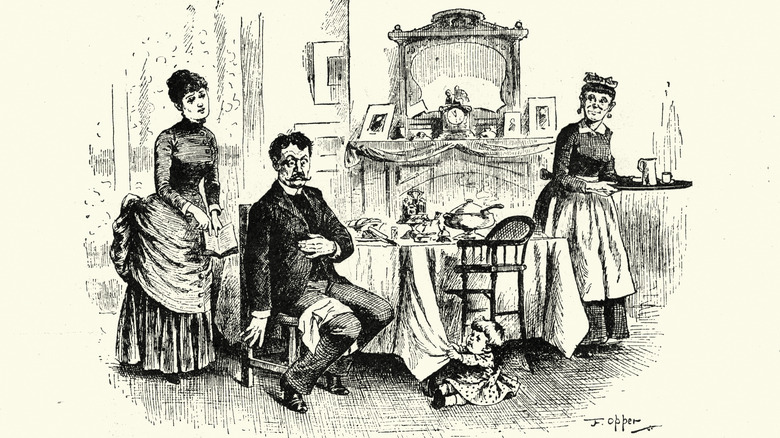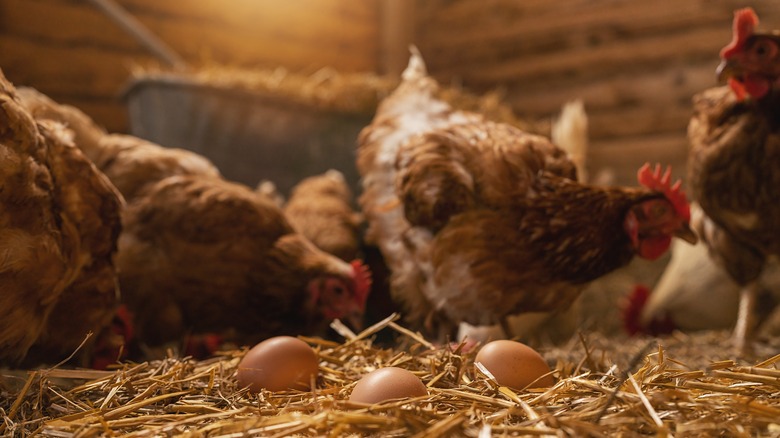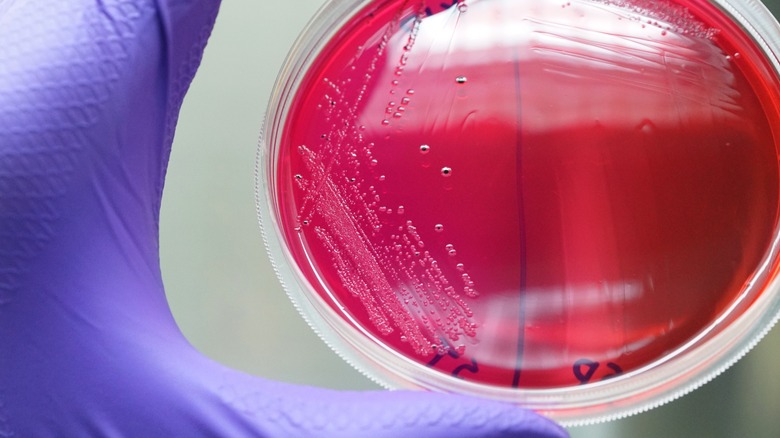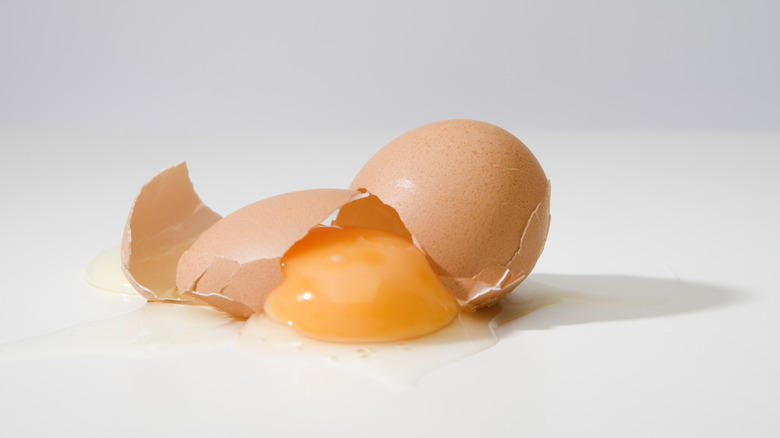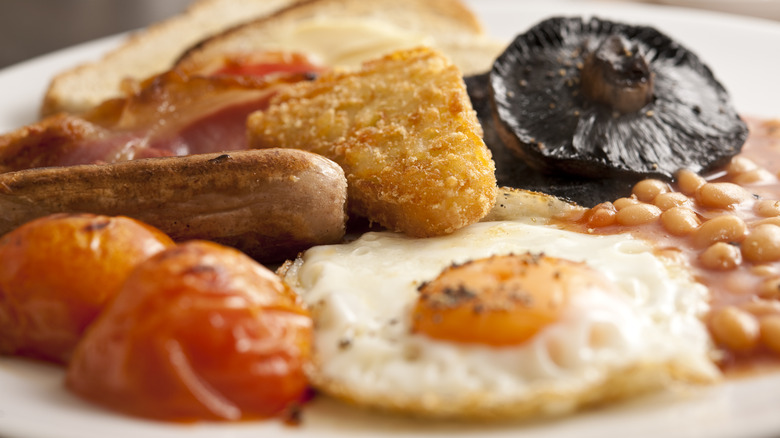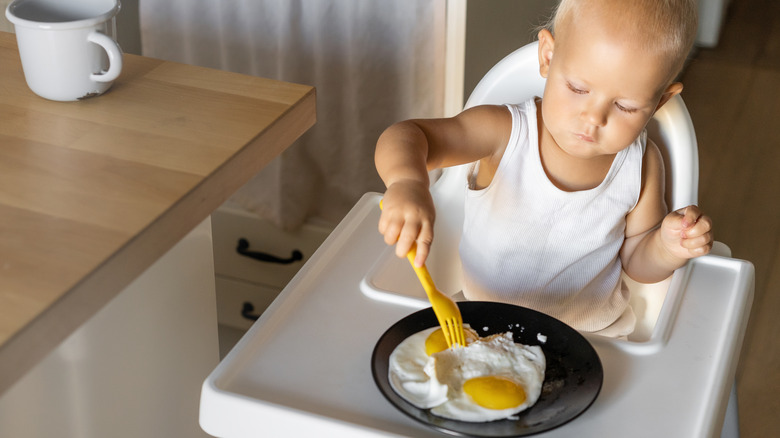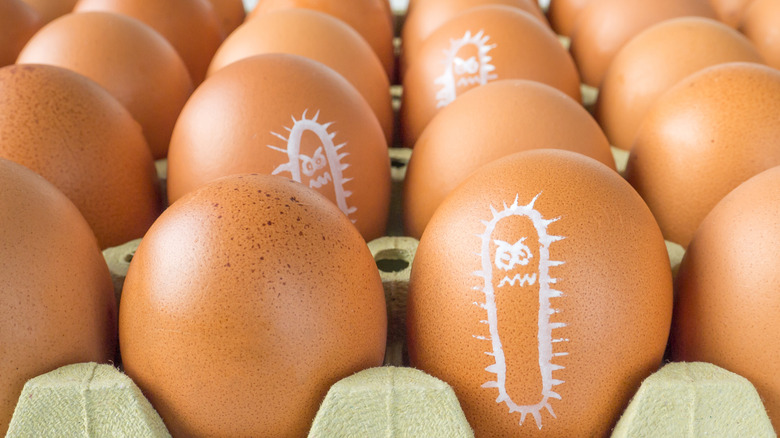From Plague To Plate: How The Fried Egg Overcame A Food Safety Scandal
A perfect fried egg with a firm white and a runny yolk is one of the greatest joys of breakfast. The yolk is a little self-contained pot of warm, delicious dipping sauce, perfectly situated to make your toast, hashbrowns, or biscuit just that little bit more delightful. And yet for centuries, some people have seemingly tried to leach all the happiness out of our morning meals by telling us not to eat fried eggs. This leaves us with a couple of burning questions: How did the delicious fried egg become the villain? And, more importantly, is it okay to eat a fried egg with a runny yolk?
Our story begins in chicken cloacas, where salmonella bacteria go to meet other salmonella, have enlightening conversations (okay not really), and proliferate inside the membrane-bound vacuoles of eukaryotic cells. Over the centuries, humans have been variously skilled or not at making sure the food supply doesn't turn into a place where salmonella and other illness-causing microbes can plot world domination. This has led to an evolution of sorts for the humble fried egg, from delicious to dastardly to delicious again. And you can thank science for (most) of it.
Fried eggs were distrusted as far back as the Middle Ages
The Middle Ages were notorious for the lack of what we consider important things like air conditioning, basic human rights, and personal hygiene. There was also very little refrigeration, indoor plumbing, or agencies like the CDC. People didn't know what salmonella was and they lacked understanding of cross-contamination. Food poisoning wasn't just common in those days; it was ubiquitous. In fact, figuring out which microbial infection killed what historical person is practically a sport among modern scientists. King Henry I? Possibly listeria monocytogenes (via Cureus). Alexander the Great? Maybe salmonella typhi (via AMHA).
Since no one at the time knew exactly what might make a person randomly double up and spend a couple of days praying to the god of whatever toilet they were using at the time, people were constantly guessing, and then instructing others how to avoid the misery of consuming the wrong food. They got the "don't eat old food" part right, at least — in an early French text, readers were warned against eating old eggs because they "putrefy quickly in the stomach" and "engender bad humors" (via "Early French Cookery").
The author claimed that fried eggs are "the worst of all sorts of preparation because they are converted into bad humors and engender vapors and nausea." Sounds a bit like projection (I ate a fried egg that made me sick, therefore all fried eggs are bad), but at least they were making the right connections.
In the early 1900s, fried eggs were thought to be bad for digestion
Suspicion about fried eggs and their effect on the gastrointestinal system persisted through the centuries. By the 1900s, people were still wondering if they should fry up an egg for breakfast. The author of 1907's "Food and Hygiene" praised eggs for their digestibility but then claimed that "a fried egg is the hardest of all to digest, the indigestibility being increased by cooking in fat."
It seems this assessment was based on science, although it's unclear whether the author knew about the research of William Beaumont. In 1838, Beaumont conducted a series of bizarre experiments involving gunshot victim Alexis St. Martin, who had a hole in his abdomen leading to his stomach. The wound gave Beaumont easy access to the poor man's stomach contents, thus allowing him to determine how long it was taking St. Martin to digest his food. Fried eggs took 3.5 hours, two hours longer than it took to digest a whipped, raw egg. Soft-boiled and roasted eggs were somewhere in the middle at 3 hours and 2.25 hours, respectively, though hard-boiled eggs were about on par with fried eggs. This seems to suggest that fried eggs are amongst the least digestible of egg preparations, though Beaumont's single-subject research wasn't exactly published in a peer-reviewed journal.
An eggshell was once thought to keep its contents safe
There's obviously a big difference between digestibility and foodborne illness. Germ theory didn't enter mainstream thought until the end of the 19th century, well after Beaumont did his experiments. Otherwise, he might not have been sticking presumably unsanitized tubes into Alexis St. Martin's stomach all the time. However, by the 1920s, people had largely accepted the idea that organisms too small to be seen with the human eye could be responsible for making you barf after eating spoiled food.
Still, people didn't always connect eggs to foodborne illness because they believed that the egg's shell protected its contents from contamination. This is probably why most people didn't question the use of raw eggs in things like eggnog and salad dressings, and why drinking raw eggs was popularized as a healthy snack practice for bodybuilders and other health-conscious people well into the 20th century.
In America, people didn't start to connect raw and undercooked eggs to foodborne illness until the 1980s, when 3,000 people in multiple states developed gastrointestinal symptoms after eating stuffed pasta that included raw eggs. This led to an aha moment among public health officials, who finally investigated certain egg farms and figured out that raw eggs were often contaminated with salmonella.
In 1987, undercooked eggs caused a salmonella outbreak
One day in 1987 New York City, some old folks had eggs for breakfast. Makes sense, as eggs are a natural food for people who don't have a lot of teeth left.
The old folks — along with a lot of other people with chronic health conditions — were patients at Bird S. Coler Memorial Hospital. One by one, 500 of them became violently ill. Two weeks later, nine of them were dead. The salmonella outbreak was traced to contaminated eggs from a specific source: DeCoster Egg Farms, one of the largest egg producers in the United States. It wasn't just that one outbreak, either. There were so many DeCoster-related salmonella outbreaks in the 1980s that some states even banned the sale of the farm's eggs.
You would think learning that you were responsible for 500 people falling violently ill in a hospital might make you, you know, randomly test an egg or two. That's not what happened. Instead, public safety officials had to force the company to allow salmonella testing. That didn't really fix things, though. In 2010, there was another DeCoster-related outbreak affecting more than 1,500 people. When investigators looked at the farm's records, they found that the company knew its Iowa operation was probably contaminated with salmonella and was continuing to run it anyway.
A British MP blamed the egg industry
Meanwhile, on the other side of the Atlantic, the Brits were watching this all go down as they dipped dainty strips of toast into the runny yolks of soft-boiled eggs and thought to themselves, "Glad that's not us." Then, in 1988, British politician and health official Edwina Currie said something potentially outrageous: that salmonella was all over U.K. eggs.
It's not super clear where Currie got her information. At the time, the BBC reported the U.K. Department of Health — the agency Currie headed — wasn't able to come up with any proof that British eggs were rampant with salmonella. The new agency even pointed out that there had only been 26 salmonella outbreaks that year, a small number given that British people ate an estimated 30 million eggs every day. Think about that number for a second ... 26 outbreaks in one year is like a salmonella outbreak every two weeks, which doesn't seem as insignificant as the BBC was trying to make everyone think it was. To many, British eggs were clean and Currie was un-British for saying otherwise.
Currie's comments had severe repercussions
British health minister Edwina Currie's 1988 comments that eggs in her country were infected by salmonella had profound repercussions. Egg sales fell by a whopping 60% almost before Currie stuck the period on the end of her sentence. Egg farmers now had to figure out what to do with 400 million eggs no one wanted. They also had to figure out how to stop hens from laying even more eggs no one wanted. The answer: Destroy the eggs and kill the hens.
The British Egg Industry Council tried to do damage control by taking out ads declaring that the chances of getting salmonella from an egg were 1 in 200 million. Based on a government assessment that British people ate 30 million eggs a day in 1988, odds of 1 in 200 million would mean there should only be around 55 cases of egg-related salmonella in England every year.
In 1989, however, The Washington Post reported that there were 12,000 U.K. food poisoning cases linked to a salmonella strain often found in eggs. That would make the true odds something like 1 in 900,000 — not bad, but the Egg Council's numbers seem off. Meanwhile, Currie did exaggerate a bit, and the scandal eventually led to her resignation.
Science confirms that sunny side up eggs are bad
By the 1990s it was pretty clear that eggs can make you sick. But what was less clear was just how risky eggs actually were. Raw eggs were obviously not a great breakfast choice, but what about fried eggs? Scrambled eggs?
Scientists actually answered that question in 1983. The problem is that most people don't read scientific journals and journalists have a habit of ignoring or oversimplifying scientific discoveries. So, the information stayed safely tucked away inside the dusty pages of Poultry Science.
Nevertheless, the scientists who published that research were clear about which cooking methods were the riskiest. Many of the most popular ways of cooking eggs are not enough to kill common strains of salmonella. Eggs need to be boiled for 7 to 12 minutes, depending on the strain of salmonella they're infected with. Fried eggs need a little less time, at about 3 minutes per side in a 147-degree pan. If you like your eggs sunny side up, forget it. Even after 7.5 minutes, researchers still found viable bacteria.
Even seemingly simple scrambled eggs require more cooking than you probably thought: 1 minute at 165 degrees for some strains, 2 minutes at 172 degrees for others. The only surefire way to ensure salmonella-free eggs, according to this research, is to make an omelet and bake it at 187 degrees for 25 minutes.
British Lion standards came to the rescue
Even though it's now very clear that undercooked eggs can make us unpleasantly ill, we still eat them. We love our raw cookie dough and mopping up hashbrowns with runny egg yolk. We're deeply, deeply disappointed with we break open an egg and find that the yolk has turned a pasty, pale yellow solid. Most people are not going to stop eating undercooked eggs because some old people in a hospital somewhere got sick.
So, like so many other things in life, it's up to the state to make sure our dumb choices don't kill us. In Britain, that took the form of the British Lion food safety scheme. Eggs produced according to British Lion standards have a lion-shaped stamp on them, meaning they come from hens vaccinated against salmonella and raised on farms that follow rigorous safety protocols. British Lion eggs are also traceable, so if there's an outbreak officials can identify which farm contaminated eggs came from.
According to British Lion, around 90% of British eggs are now produced under British Lion Standards. The site even features a video from the now-vindicated Edwina Currie, who says she has no regrets for raising the alarm in 1988. After all, she wasn't trying to destroy the British egg industry. Instead, she just wanted people to enjoy their eggs safely.
A British food safety committee said new protocols worked
Safety standards are all well and good, but only numbers will tell us whether or not they actually work. In 2017, the British Advisory Committee on the Microbiological Safety of Food came up with just the numbers. In an 182-page analysis of the state of British eggs, the committee concluded that the British Lion safety protocols were responsible for a significant decline in the number of salmonella infections in the U.K.
According to the analysis, between 2008 and 2014 the prevalence of salmonella enteritidis in egg-laying flocks had fallen below the 2% target and well below where it had been 10 years earlier. The committee also noted that there had been no salmonella outbreaks linked to British Lion producers in nearly seven years thanks to vaccinations and other safety standards.
The committee also noted that, while there had been great strides in making chicken eggs safer, there was still a concern about other types of eggs, including duck and quail eggs. In 2010, there was an increase of salmonella typhimurium infections in England and Northern Ireland of 26% and 41% respectively, both of which were strongly associated with the consumption of duck eggs.
In 2017, the British Food Standards Agency revised its guidelines
The British Lion scheme was so successful that in 2017 public health officials changed their advice about eating runny eggs. A risk assessment report issued by the U.K. Food Standards Agency (FSA) noted that eggs produced under British Lion rules had a very low risk of salmonella contamination. Based on this, the FSA issued the remarkable advice that vulnerable groups, which include babies, young children, seniors, and pregnant people, could go ahead and eat lightly fried eggs without concern.
In June 2023, the FSA did a follow-up evaluation of the state of British eggs and concluded that there was no need to re-assess the risk. British people could keep dipping strips of toast into soft-boiled eggs without fear of a gastrointestinally-mandated trip to the porcelain throne.
So, was there a nationwide celebration? People publicly consuming the contents out of uncooked eggs during breakfast is back parades through the streets of London? Not really. The Guardian did run an article featuring a photo of Edwina Currie holding a dinosaur-sized British Lion egg and noted that care homes would be able to serve traditional egg dishes again. For the most part, though, no one was partying. That's because many may have gone back to eating runny eggs a month or two after the fried egg scandal of 1988. For some, the news was likely more validation than it was permission.
The CDC still warns against eating undercooked eggs
It's safe to eat undercooked eggs in the U.K., so what about the U.S.? Well, the nation that arguably likes to think of itself as the world's most advanced countries has not quite figured out how to make its homegrown eggs as safe as British ones. Today, around one in 20,000 American eggs are infected with salmonella, as per the Egg Safety Center. This means you'll encounter a contaminated egg once every 84 years, theoretically. That's probably fine as long as it's not around the first or 84th of your years, as the very old and the very young are the most likely to suffer severe issues stemming from a salmonella infection.
The U.S. has now embarked on a similar strict safety protocol ... just kidding. American eggs are typically washed and disinfected before sale, but there's no requirement for chickens to be vaccinated against salmonella like under British Lion rules. Some producers voluntarily vaccinate hens, but no one's making them. Until vaccination becomes commonplace on American egg farms, the number of salmonella-infected eggs will probably remain more or less the same.
This is why the CDC still recommends against eating undercooked American eggs. But let's be real: it's easy to imagine that many of those who signed off on that warning still totally sit around the breakfast table eating fried eggs with runny yolks. We'll bet that hardly anyone likes a firm yolk, not even the people of the CDC.
